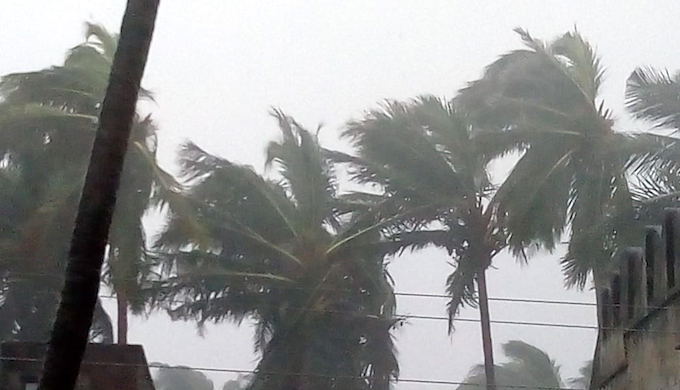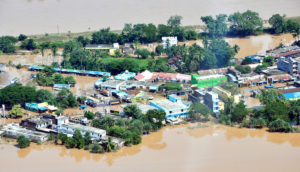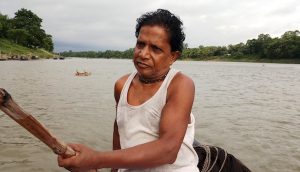The southern coast of Odisha, with the small port town of Gopalpur at its centre, seems to have become a favoured destination for tropical cyclones occurring from October to November in the Bay of Bengal. This year, coastal districts of Odisha and neighbouring Andhra Pradesh on the east coast around Gopalpur faced two intense tropical cyclones – Daye in September and Titli in October.
Gopalpur has been facing a constant threat of post-monsoon tropical cyclones since at least 1999 when it was badly hit by a devastating tropical cyclone 10 days before the super cyclone of 1999. That super cyclone hit near Odisha’s port town of Paradeep in the early hours of 29 October and ravaged large parts of coastal areas, leading to at least 10,000 deaths.
Climate campaigner Oras Tynkkynen described the impact of the pre-super cyclone that hit Gopalpur on 18 October, 1999 in his report Orissa Cyclone, “With wind speeds of around 200 km per hour and large tidal waves, it killed around 500 and affected two million people.”
The subsequent super cyclone of 29-30 October 1999, had a wind speed of up to 260-270km per hour in the core area to produce a huge storm surge that led to sea-level elevation of more than 20 feet, according to India Meteorological Department. “Both the cyclones affected approximately 15 million people and damaged three million homes,” Tynkkynen said in his report.
A tropical cyclone, also referred to as a typhoon or hurricane, is an intense circular storm that originates over warm tropical oceans and is characterised by low atmospheric pressure, high winds and heavy rain, according to the Encyclopaedia Britannica. Drawing energy from the sea surface and maintaining its strength as long as it remains over warm water, a tropical cyclone generates winds that exceed 119 km per hour. In extreme cases, winds may exceed 240 km per hour, and gusts may surpass 320 km per hour.
Recurrent hits
Fourteen years after the super cyclone, the severe cyclonic storm Phailin hit Gopalpur on the southern coast of Odisha on 12 October, 2013. With a wind speed of 200 km per hour, this very severe cyclonic storm (VSCS) affected about 13.2 million people, took a toll of over 40 lives and caused losses amounting to Indian rupees 42.4 billion (USD 688 million), while damaging crops over 500,000 hectares of farmland.
The hiatus of 14 years between the super cyclone of 1999 and Phailin in 2013 did not last, he next storm hit Odisha much more quickly. Gopalpur was under the threat of being hit by another VSCS Hudhud the very next year, 2014. Somehow, the small port town escaped the major wrath of Hudhud as it changed direction and made its landfall near the city of Vishakhapatnam of Andhra Pradesh on 12 October, 2014. The whole of southern Odisha was severely affected by the storm because of strong wind and heavy rainfall during the landfall and its aftermath.
This year, the southern coasts of Odisha had to face two tropical cyclones in less than a month, between September 20 and October 11, 2018. While the tropical cyclone Daye made the landfall near Gopalpur on September 20, VSCS Titli made its landfall in Andhra Pradesh coast, adjacent to Gopalpur further south.
Titli killed 30 people and severely affected Gajapati, Kandhamal and all coastal districts of Odisha along with Srikakulum and Vizianagaram districts of the neighbouring state by causing widespread damage and heavy rain leading to flood situation in its aftermath.
In a statement the UN General Secretary António Guterres has shown his solidarity with the government of India as “Millions of people have been affected in Odisha mainly in the worst-hit districts of Ganjam, Gajapati, and Rayagada, and thousands of houses were damaged in Andhra Pradesh. Cyclone Titli also disrupted road and telecommunications networks and power supplies.”
“Increasing frequency of cyclonic storms with higher intensity hitting Gopalpur and adjacent coastal areas during the month of October over past five years has created panic among people living in coastal villages and threatened their livelihood as most of them depend on fishing,” said Mangaraj Panda of Ganjam-based United Artists’ Association who work on the welfare of marine fisher communities living in coastal villages.
Temperature rise
“These are all cyclonic storms originated in the Bay of Bengal which is very much cyclone-prone like north Atlantic Ocean, the eastern and western parts of the northern Pacific Ocean, and the south-western Pacific Ocean. The months of October and November are the usual cyclone season for the Bay of Bengal because the conditions are favourable for cyclones to form,” H.R. Biswas, Director of Regional Meteorological Centre, Bhubaneswar, told indiaclimatedialogue.net.
According to the Weather Channel, tropical cyclones are intense water-rotating systems formed by strong winds (of speeds of at least 62km per hour) around low-pressure areas. They have a spiral, anticlockwise movement. Additional weather conditions like high sea surface temperature, vertical changes in wind speed inside the spiral, and high relative humidity help cyclones form and intensify.

“Since sea surface temperatures and humidity both directly correlate with chances of cyclone formation, the Bay of Bengal is a more likely target because it gets higher rainfall, and because the sluggish winds around it keep temperatures relatively high: about 28 degrees around the year. Warm air currents enhance this surface temperature and aid the formation of cyclones,” it said.
Sea Surface Temperature (SST) is a fuel to tropical cyclones for their genesis and intensification. Global warming heats both the sea surface and the deep water, thus creating ideal conditions for a cyclone to survive and thrive in its long journey from tropical depression to Category Four or Five super storms.
SST is increasing fast in the equatorial Indian Ocean, compared with other oceans. It has increased by 0.6 degree Celsius in the northern Indian Ocean since 1960, the largest rise among the tropical oceans. Recent increases in the severity of tropical cyclones in Bay of Bengal region is being attributed to the increase in SST, Ashutosh Mishra, a geographer, wrote in a paper.
According to researchers at the Pacific Northwest National Laboratory and the National Oceanic and Atmospheric Administration, Bay of Bengal’s cyclone environment were caused by decades-long changes in the El Niño Southern Oscillation, or ENSO, a regular pattern variation of winds and sea surface temperatures affecting the tropics and sub-tropics. The ENSO triggers an atmospheric wave that helps instigate the May-June monsoon circulation over the Bay of Bengal, which then becomes responsible for initiating tropical cyclone activity.
“Because of global warming, sea surface temperature remains higher in the Bay of Bengal leading to generation and intensification of cyclonic systems. The southern coasts of Odisha experience cyclonic storms more frequently since Phailin cyclone of 2013,” Sarat Chandra Sahu, director of the center for environment and climate at SOA University, told indiaclimatedialogue.net.
“Through transaction between land and sea, land surface temperature is also being transferred to the sea surface, making it warmer. When sea surface temperature reaches 26.5 degrees Celsius, it can help formation of a cyclonic storm. More temperature would add further strength to it for intensification. During formation of Titli, surface temperature in the coastal sea was 30 degrees Celsius,” Sahu said.
Asked about the reason why cyclonic storms are making frequent landfallaround Gopalpur, Sahu said that rapid urbanisation, deforestation and developmental activities could be the reason, although no specific study on this has yet been done.
Stating that cyclones occur due to depressions in the ocean, and certain areas like the coast Odisha and the Nagapattinam area of Tamil Nadu visited by cyclones more frequently, eminent scientist and father of India’s Green Revolution M.S. Swaminathan told indiaclimatedialogue.net, “In fact, there is no clear reason why such extreme weather events take place more frequently in some areas. We can, however, use this information to take anticipatory action on cyclone management.”
Urgent action needed
Climate change, induced by environmental degradation, not only helps creating favourable conditions for such extreme weather events but also adds to their strength, said Surjendu Kumar Dey, head of the department of environment science at Balasore-based Fakir Mohan University.
“The coastline of Odisha is now open to all kinds of vagaries of the nature as it has lost most of its mangroves, which was protecting villages, people and their properties from the wrath of cyclonic storms. Adding to the plight of people by encouraging climate change are the port and other industries that have come up around Gopalpur,” said Mangaraj Panda.
Raising the issue of development at the cost of environment, John Knox, special rapporteur of the United Nations on human rights and the environment, says, “Pursuing short-term economic gain in disregard of environmental costs is chasing fools’ gold. Without a healthy environment, economic gains are unsustainable.”
Climate change is likely to already be having an effect on local weather patterns across the world, as Tynkkynen said in his report, “An increase in the frequency and force of extreme weather events (such as cyclones) fits with many predictions on what climate will be like due to global warming. A computer simulation suggests that if tropical sea surfaces warm by a little more than 2 degrees, the strongest hurricanes will have wind speeds of 5–12% higher than earlier – i.e. the worst tropical storms will get even worse.”
“Developing a natural protection system through thick mangroves and forests along the coastline could be the way to escape impacts of climate change and the wrath of cyclones,” Dey said while suggesting the government should think about building small but safe cyclone shelters in all coastal villages to ensure safety of people and strengthen disaster resilience at the community level.
The Intergovernmental Panel on Climate Change has issued an alert to the policy makers very recently calling for prompt action to keep temperature rises within limit to slow down the process of climate change and minimise its impacts. It is high time for the Odisha government to initiate action to save its people, their properties and coastal infrastructure from cyclonic storms.







